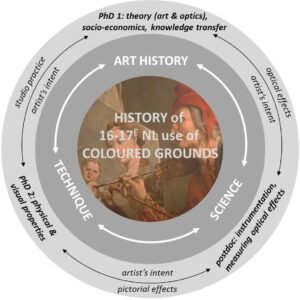Category
PARTNER PROJECT
(COLLABORATIVE)
Start
2019
Status
Active
The colour of ground layers, applied to prepare supports for painting, has a profound effect on painting methods and the visual characteristics of finished pictures. In the Renaissance, painters used white grounds. Coloured grounds originate in late 15thcentury Italy and spread North around 1550. They gave rise to a new way of painting, with an emphasis on tonality and chiaroscuro.
Currently we have no overview of the transfer mechanisms that influenced their successful spread to the Netherlands, their impact on painting technique and visual effects, and the influence of advances in Early Modern optics and colour theory on their development.
In Down to the Ground, art historians, conservators and scientists investigate the impact of coloured grounds through three interwoven subprojects, focusing on the spread of coloured grounds, the role of ground colour in the painting process, and the development of innovative non-invasive depth-resolved spectral imaging instrumentation (DRSI) to support research into visual and optical characteristics and colour changes. The project will provide insight into the mix of cultural and technological factors that allowed coloured grounds to develop, disclosing their influence on the character, methods and visual appearance of Netherlandish Golden Age paintings.

Project set-up Down to the Ground project. Image: detail of Maerten van Heemskerck, Saint Luke painting the Virgin (1532), Frans Hals Museum, photographed by Margareta Svensson
Funded by:
